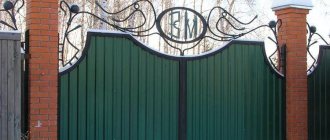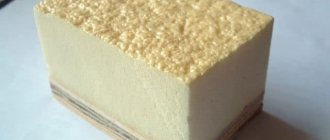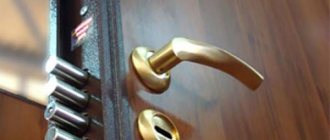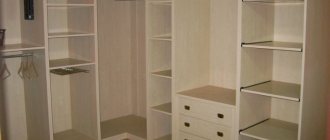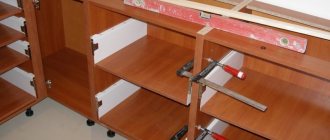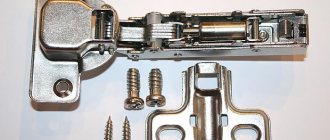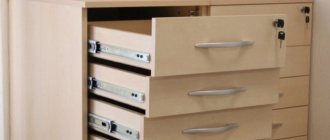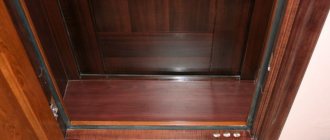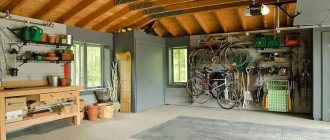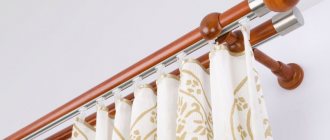It is believed that if the temperature inside the garage does not drop below +3C, then the car engine can be started, as they say, “half a turn”. Therefore, owners today pay special attention to the insulation of metal garages. Moreover, there are thermal insulation materials on the market today, with the help of which the insulation process is carried out simply and quickly, plus the costs for this event are not very large. Therefore, in the article we will consider all the methods of insulating garages built from a metal profile sheathed with sheet iron or corrugated board.
How to properly insulate a metal garage Source gallery.ykt.ru
Where is it better to insulate - inside or outside?
Some garage owners argue that it is better to insulate the room from the outside, as this will significantly save interior space. We really have to agree with this. Some thermal insulation materials begin to release substances harmful to humans into the air when interacting with the environment. They are dangerous to install indoors, but they are perfect for external thermal insulation.
But there is also the other side of the coin - the insulation materials used will be constantly affected by precipitation: snow, rain, hail, strong gusts of wind, etc. Therefore, the service life of materials is reduced to 2-3 years, while indoors they can last 10 years, or even more.
You can insulate the garage both outside and inside at the same time. At least the roof. This will help get rid of condensation that may collect on the roof and drip through cracks.
Entrance trim
Insulating walls will not be beneficial if cold air enters through the cracks of the entrance gate or wicket. The situation is easily solved by using rigid insulation such as polystyrene foam. First, the gates are insulated, then the small entrance door to them is insulated. The sequence is:
- The metal surface is treated with protective mastic. Expanded polystyrene is not afraid of moisture, however, when opening the gate, raindrops or snow can get into the cracks between the material and the iron sheet. This should not be allowed.
- Attach lathing profiles along the perimeter of the gate.
- Fix the polystyrene plates to the mounting adhesive; it is advisable to apply penofol (a foil-based material) on top of them.
- Make a wooden sheathing for installation of the cladding. Provide a distance of about 30 mm between the future lining/plasterboard/other cladding material and polystyrene foam, so that there is an air gap.
- Fix the cladding to the sheathing.
- Perform similar actions with the gate.
The most common insulation materials
Mineral wool. This material has been used in room insulation for about 50-60 years. Mineral wool itself has several types. Basalt mineral wool is more suitable for insulation. It does an excellent job of blocking outside noise and retaining heat by keeping air circulating in the garage.
Mineral wool is produced in the form of soft, medium-hard and hard mats. It is better to purchase rigid types of insulation, as they are the most durable and do not allow moisture to pass through as much. In addition, rigid mats are easier to attach, and in the future they will not slide off the walls of the garage.
The advantage of this material is that it does not require special skills or tools to work with it.
Reference! Mineral wool is very afraid of moisture. Therefore, when purchasing this insulation, it is necessary to purchase waterproofing materials.
Glass wool. This is the cheapest heat-insulating material. This is where its advantages end. However, garages insulated with glass wool retain heat well inside. It is made from waste from the glass industry, so it has a lot of small glass elements. To work with this insulation, you must wear gloves, outerwear and goggles, since when it comes into contact with the skin or eyes, its particles cause discomfort, itching or injury.
Glass wool has a rather unpleasant odor. It needs to be well protected from moisture, because when wet, the cotton wool crumples and completely loses its heat-insulating properties.
Styrofoam. It is also a popular material for insulating heat indoors. Polystyrene foam is cheap and can be used for 10 years. It does not rot, is not afraid of fungus, the material is light and convenient, since it can be used to insulate walls alone.
But foam plastic also has significant disadvantages. It practically does not allow air to pass through, so good ventilation should be ensured in the garage. The joints of the plates must also be carefully coated with sealant, otherwise condensation will accumulate in the cracks. It can withstand chemicals, but can be damaged when exposed to direct sunlight. In addition, rodents may suddenly appear in the foam. They are capable of destroying the entire thermal insulation layer in a few years. Therefore, it is worth thinking about measures to protect against mice.
Penoflex (extruded polystyrene foam). Some experts claim that this is the best option for insulating rooms. It is cheap and even easier to install than polystyrene foam - its joints do not need to be sealed, since they have special grooves in the shape of the letter “L”. It is easy to cut and glue.
It copes well with the assigned thermal insulation task. It is worth noting that the material has a very low moisture absorption rate, which means that penoflex does not get wet and is not afraid of seasonal temperature changes. Many say that this insulation can be used for up to 50 years.
Penoflex is not susceptible to rotting and insects do not appear in it. In addition, the material has excellent sound insulation. Therefore, this insulation can be used for both internal and external insulation.
Polyurethane foam. It is popular due to its resistance to weather conditions. After application, the material stretches and fills all voids, and also reliably adheres to the wall and ceilings, so it does not need to be additionally sealed. In order to insulate a garage using polyurethane foam, it is necessary to use special equipment that sprays the material onto the walls in liquid form, after which it hardens and forms continuous layers of hydro- and thermal insulation. In addition, the material is not flammable and can be used for up to 50 years.
Most likely, to apply polyurethane foam you will have to resort to the help of specialists. Today, there are many companies that insulate garages using material. Therefore, when using polyurethane foam you will have to spend a lot of money.
Reflective thermal insulation. It's a kind of foil with an extra layer. It is quite effective as it reflects heat into the room.
The thickness of the reflective layer can reach up to 50 mm. It reflects infrared radiation well, so it is used mainly for heated rooms.
Warm plaster. It can be used if the garage walls are made of brick or cinder blocks. The plaster contains heat-protective elements such as vermiculite, processed sawdust or expanded polystyrene.
To be effective, you will have to apply a thick layer of this material, and this can greatly increase the load on the walls of the garage.
Warming paint. The layer of this paint is 1 mm. But the thermal insulation layer can be compared in its qualities to mineral wool, whose layer thickness is 50 mm. Paint is made using polymers to which synthetics are added. It is not at all difficult to apply to the surface.
Video description
We invite you to watch a video that shows the technology of thermal insulation of a metal garage with polystyrene foam boards:
See also: Catalog of companies that specialize in insulating country houses.
Additional wooden frame
This option for insulation and finishing is used if the frame of a garage building is assembled from a steel corner. To do this, wooden blocks with a cross-section equal to the side of the corner profile are installed on both sides of the corner elements. Usually this is 40 mm, which means you will need 40x40 mm bars.
They are attached to the frame structure in different ways, for example:
- tie two bars of wire to the corner on both sides at once;
- attach each block to the garage wall , that is, to a metal sheet, making holes in it and securing it with self-tapping screws, which are screwed in from the outside.
That is, another frame should appear on the inner wall, only wooden. It is the dimensions of the newly formed rectangles that are used as the basis for trimming the polystyrene foam boards. After which they are also inserted into the spaces between the frame elements and secured with adhesive. Sometimes glue is not used if the trimmed pieces of insulation fit tightly into the wooden structure of the sheathing. They won't fall out, especially since they will be covered with casing.
Now any finishing lath, slab, or sheet material can be installed on a wooden sheathing using standard technology.
Thermal insulation with polystyrene foam with installation of a wooden frame Source 2gis.ru
Required materials and tools
It all depends on what material will be chosen for insulating the garage. But, in any case, the following tools may be required:
- Screwdriver;
- Screwdriver;
- Putty knife;
- Glue;
- Painting knife;
- Fastening elements;
- Hammer.
You need to remember about protection, especially when working with glass wool, so you will need gloves and goggles.
You should think about a stepladder or sawhorse so that you can insulate the ceiling.
How to insulate a cellar in a garage
Insulating a cellar in a garage is technologically not much different from insulating premises for other purposes, but has several important nuances. The main one is increased humidity due to direct contact of the walls and floor of the cellar with the soil. Therefore, waterproofing becomes a key step.
Ideally, it is better to apply a layer of waterproofing to the outer surfaces of the walls, creating an airtight capsule around the cellar. However, in an already built garage or a garage located in a cooperative, it is sometimes impossible to reach the outer surface. In this case, waterproofing is done from the inside.
Polymer films, roll insulation or bitumen mastics can be used as a waterproofing material. The result should be a complete layer of waterproofing. A special vapor-waterproofing membrane is suitable for insulating the ceiling.
Then, insulation is laid on the walls, floor and ceiling: mineral wool, polystyrene foam or extruded polystyrene foam. For mineral wool, you will need to build a frame, and sheets of polystyrene foam are glued to surfaces or secured with plastic dowels with a mushroom cap.
A wooden frame for installing mineral wool must be treated with protective compounds.
The top layer of insulation is covered with a vapor barrier. After which you can begin covering it with decorative materials, for example, plastic panels.
Step-by-step instructions for insulating a metal garage
In order to reliably insulate a room, it is necessary to protect not only the walls, but also the floor, ceiling and gates.
Ceiling insulation
It is better to insulate the ceiling with foam plastic.
- If the ceiling is wooden, then the material can be secured with nails. If the top is concrete, then it is necessary to make a preliminary frame in which the foam is fixed. In this case, the material can be secured with electrical tape and then covered with plywood or clapboard.
- All joints and gaps must be sealed using polyurethane foam.
- The surface must be impregnated with antiseptics, cleaned and painted.
Wall insulation
Instructions for insulation with mineral wool
- Make a frame.
- Mineral wool is placed in it and fixed with special clamps.
- The top of the insulation is covered with a vapor barrier material.
- They do decorative finishing.
Wall paint
You already know how to insulate a metal garage from the inside. But we insulate not only from the inside, but also from the outside.
In the case of exterior finishing, it is unlikely that the right solution would be covering it with some kind of siding and other panels. Expensive, not always effective.
Instead of sheathing the garage, it is better to apply a heat-insulating layer of special paint to the surface.
Painting can reduce the thermal conductivity of metal walls and roofs. Therefore, it is recommended to use mixtures with low thermal conductivity.
Here I can recommend the following options:
- Astratek
. It is a water-based liquid insulator that consists of ceramic components; - Isollat
. Includes acrylic dispersion, ceramic microgranules, as well as fiberglass, perlite and a number of additives; - Corundum
. There is a water base, ceramic microgranules, as well as various fillers and additives.
The presented paints are produced for exterior work, interior decoration, as well as for painting specific elements. These can be pipes, walls, ceilings, floors, etc.
Arrangement of gate lathing
- After fixing the sheathing, the slab material is cut to the required size (as accurately as possible to avoid large gaps).
- It is glued to the base and the seams are sealed with polyurethane foam.
- Next, finishing is carried out using forcing or other material. OSB panels and plywood are also used for sheathing.
Izolon or a regular layer of foil glued on top of a sheet of foam multiplies the heat-reflecting effect several times. Many people heat the UFO garage with a radiator. The rays from the foil base are well reflected, even under the skin.
Features of siding application
Before sheathing the outside of the garage, you should familiarize yourself with the variety of siding, which includes the following types:
Vinyl siding is considered the most popular due to its reasonable cost and good performance characteristics. It is made from polyvinyl chloride, which is moisture resistant and has a simple installation method.
The main advantages include fire safety, resistance to temperature changes, a large selection of palettes, durability, and low weight of the panels.
Wooden siding is characterized by environmental friendliness, safety, and increased thermal insulation, but it has a high cost, so it is not advisable to use it for finishing a garage.
Metal siding differs from other types in its increased strength, resistance to temperature changes and mold, and in order to prevent corrosion, it is recommended to use self-tapping screws with a rubberized head.
Cement siding has significant weight, which creates an increased load on the garage foundation. Therefore, it is necessary to find out whether the walls and base of the garage can withstand such weight.
Using lining
In some cases, lining, which is made from coniferous and deciduous trees, is used to cover the outer walls of garages. It is a safe and natural material and has a special tongue-and-groove fastening, which makes it easy to connect the panels to each other.
There are several classes of lining, and the most ideal option is premium class material, which is characterized by excellent quality and a fairly high price, but it does not allow the presence of any defects or flaws on both surfaces. For a garage, you can use class A, which refers to the first grade and allows minor defects while maintaining the normal quality of the panels.
The most popular type recently is eurolining, as it is produced under strict control and meets all established European norms and standards.
Mineral wool
Preparation of the base for insulation is carried out similarly to the previous option, but insulation of the garage walls from the inside in this case will differ in technology. First, you should assemble the sheathing from wood or metal parts. Usually, these are familiar profiles intended for installation of gypsum plasterboard structures. The installation step of the elements almost corresponds to the width of a roll of mineral wool or a hard mat made of the same material, but slightly smaller. This way the insulation will be securely fixed in the cells of the frame.
Next, you should take care to protect the insulator from moisture and lay a layer of waterproofing. Rigid mats of cotton wool insulation are placed inside the cells or pieces of rolled wool cut to size are inserted. The resulting structure is covered with a layer of vapor barrier and decorated to your liking. It should be taken into account that mineral wool will completely lose its properties when it gets wet and protect it as best as possible from water.
